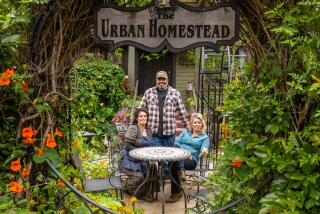Op-Ed: The family farm is in Illinois, but the family is in Alabama
- Share via
Across America, farm families — including mine — are grappling with big changes.
In April, my 81-year-old father was diagnosed with advanced congestive heart failure on the same day Mom was transferred to a nursing home. I dropped off my youngest daughter at school and began the familiar trek from Birmingham, Ala., to central Illinois to help my parents navigate this most recent health crisis.
As difficult as the past months here have been, juggling doctors’ appointments, calls to insurance companies, and consultations with a host of specialists, there’s a larger dilemma looming — how I’ll manage when the time comes to take over my family’s mid-size grain farm.
For four generations, Ryans have lived and worked in DeWitt County. From a logistical standpoint, I wonder if it’s possible for me, a fifth-generation heir who lives 600 miles away, to call myself a farmer.
When I question the feasibility of succeeding as an absentee farmer, I remind myself that change has always been a given in agriculture.
Even after “retiring” in 1998, my father continued to drive loads of corn and soybeans to the local grain elevator and kept tabs on crops tended by two tenants. For him, being a farmer has always meant digging your hands in the soil, counting rows on random ears of corn to estimate yield and checking a plant’s color and “hang” from the seat of his pickup, windows rolled down.
Although I can learn the same tricks of the trade, I can’t always be here to practice them. My husband and I are tenured university professors, and our two daughters are certified Southerners whose time on the farm consists of summer visits and holidays with their grandparents. I and my offspring share a legacy that is located far from where we’ve set down roots of our own.
When Dad is gone, no Ryan will be involved in the day-to-day labor of farming. And with that change comes the close of a chapter in our family’s story.
As a child, I woke to the sounds of Dad and his brother working on a tractor or a combine in the shed out back. I listened to the noonday radio report on grain prices the way my teenagers absorb the latest Instagram post. I sat at the kitchen table after my own supper watching Mom warm up Dad’s when he came in late, tired and dirty from planting or harvesting.
Nowadays, when I return to the farmhouse, it’s the tenants, Bob and Fritz, I hear readying machinery outside, and their trucks I see pulling away at the close of day. They’re the ones I consult about bills for seed, fertilizer and crop insurance when Dad is too sick to guide me. Their presence confirms that the Ryan farm is officially among the 40% of U.S. farms worked not by landowners but tenants.
That’s a surprising statistic for a nation that romanticizes the family farm. Or maybe not. In my case, and in others no doubt, the farm is at least still in the family, even if the family is located hundreds of miles away. When I question the feasibility of succeeding as an absentee farmer, I remind myself that change has always been a given in agriculture.
As a boy, Dad watched his father maneuver a horse-drawn two-row planter. He and my uncle used an eight-row planter pulled by a tractor with an air-conditioned cab. The largest planters these days handle 32 rows at once, and in the not-too-distant future, farms will employ autonomous machinery — the kind that doesn’t require a farmer behind the wheel at all. It’s hard for me to even imagine how different life was for Thomas J. Ryan, the first of my ancestors to purchase Illinois farmland in the 1870s, after immigrating to this country from Ireland. In a multigenerational farm family, the stewards change, and so do the tools and the best practices that allow them to pursue their dreams.
I could spare myself the hand-wringing and simply sell the farm when my parents are gone. Land prices have soared in recent years, and my family could live quite comfortably on the proceeds. But my agrarian roots still ground me after all this time, which makes holding on to the farm, even from a distance, the richer choice.
Besides, selling would mean giving in to another disturbing trend in U.S. agriculture. According to the USDA census issued in 2014, the total number of U.S. farms decreased by 4.3%, some 90,000 operations, between 2007 and 2012, while the average farm size increased by 434 acres. The shift reflects an aging population of primary farm operators like my father and the consolidation of small to mid-size family farms into larger operations. This may be the fate of our land someday, given rising farm expenses and increased pressure to boost production and efficiency by scaling up, but I’m not ready to abandon the life my family built.
When the moment arrives to step fully into Dad’s well-worn work boots, I’ll have many more decisions to make. I’ve worried plenty about what lies ahead for this place and my role here. But entrusted with a fragment of the past in a disrupted, shifting present, I am gradually finding my footing, trying to keep the Ryan farm going for another generation.
Cynthia Ryan is a teacher, writer and, increasingly, a farmer dividing her time between Alabama and Illinois.
Follow the Opinion section on Twitter @latimesopinion and Facebook
More to Read
A cure for the common opinion
Get thought-provoking perspectives with our weekly newsletter.
You may occasionally receive promotional content from the Los Angeles Times.









